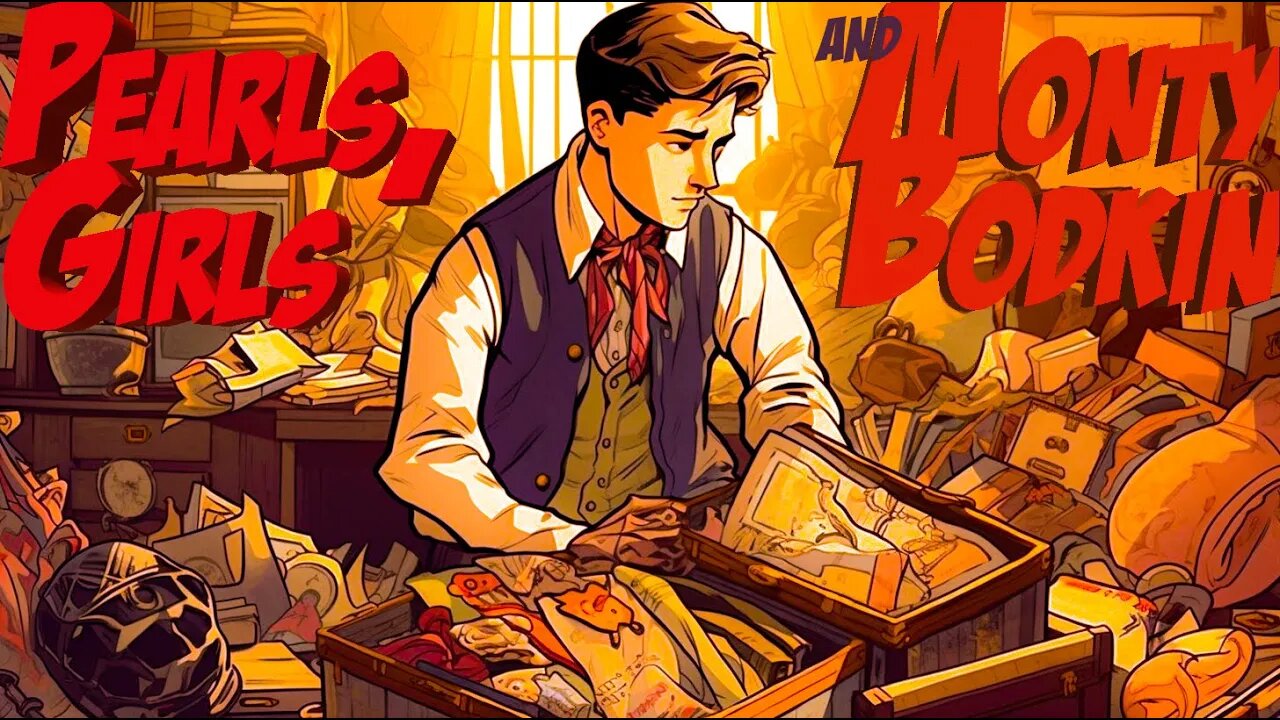Premium Only Content

Pearls, Girls and Monty Bodkin 🤵💎 PG Wodehouse 🎬🥂
"Pearls, Girls, and Monty Bodkin" is a comedic novel by British author P.G. Wodehouse. It was first published in the United Kingdom by Barrie & Jenkins in 1972 and subsequently in the United States by Simon & Schuster in the same year. The novel is a sequel to "The Luck of the Bodkins" (1935) and "Heavy Weather" (1933), featuring Monty Bodkin as the central character.
"Pearls, Girls, and Monty Bodkin" is a lighthearted comedic novel by P.G. Wodehouse. The story follows the charming and somewhat naive Monty Bodkin, who is trying to deliver a pearl necklace. Set against the glamorous backdrop of the Roaring Twenties, Monty's journey leads him into Hollywood and high society, where he encounters eccentric personalities and becomes entangled in various humorous situations. The novel weaves elements of romance, farce, and witty banter, creating a delightful and entertaining read showcasing Wodehouse's signature wit and style.
The artwork in this audiobook is original, at least as authentically original, as a combination of Midjourney and Photoshop may make it so. However, to select art that best represents the charm and humor of P.G. Wodehouse's works, it's essential to consider artists whose styles reflect the dynamism, innovation, and complex emotions of the Roaring Twenties.
The following artists were used as inspiration when deriving art for this audiobook presentation:
1. Berthe Morisot's Impressionist style continued to influence artists in the 1920s, capturing the dynamism and excitement of the era.
2. George Grosz's satirical portrayals highlighted social inequality and the excesses of urban life, reflecting the darker side of the Roaring Twenties.
3. Giacomo Balla's Futurist focus on movement, speed, and technology resonated with the era's rapid pace of change and optimism.
4. Tamara de Lempicka's glamorous Art Deco paintings epitomized the Roaring Twenties' sophistication, luxury, and modernity, celebrating new freedoms for women and urban life allure.
5. Wassily Kandinsky's pioneering abstract art was influenced by rapid societal changes, exploring new forms of expression and spiritual aspects of art.
6. Fernand Léger's bold, geometric Cubist style captured the energy and modernity of the era, reflecting industrialization and technological advancements.
7. Marc Chagall's dreamy, poetic paintings offered an alternative perspective to the era's materialism and superficial glamour, tapping into emotional and spiritual currents.
These artists contributed to or were influenced by the Roaring Twenties, reflecting the dynamism, innovation, and complex emotions of this era of rapid change.
-

Dr Disrespect
8 hours ago🔴LIVE - DR DISRESPECT - WARZONE VERDANSK - EXTREME CHALLENGES
98.5K6 -
 26:31
26:31
Glenn Greenwald
5 hours agoTrump at the NATO Summit: Michael Tracey Reports from The Hague | SYSTEM UPDATE #477
46.4K9 -
 LIVE
LIVE
RiftTV/Slightly Offensive
4 hours agoSHOCKING: Pro-Israel Extremist CRUCIFIES Christian Pastor | The Rift
720 watching -
 LIVE
LIVE
The Breanna Morello Show
6 hours agoAutopen Scandal Gets Worse, Commie Take Over in NYC?, FBI Whistleblowers Need Help, Dividing MAGA- The Breanna Morello Show
304 watching -

ZeeeMedia
4 hours agoBanks Make Shock Move, Signals of Looming Economic Storm | Daily Pulse Ep 55
1.45K2 -
 1:04:38
1:04:38
BonginoReport
3 hours agoWho’s Your Daddy?! Internet Erupts After Viral Trump Moment (Ep.78)
155K31 -
 1:01:38
1:01:38
The Nick DiPaolo Show Channel
4 hours agoHegseth Drops Bunker Bomb On Fake News | The Nick Di Paolo Show #1757
22.6K16 -
 LIVE
LIVE
SpartakusLIVE
3 hours ago#1 Verdansk HERO || Live EARLY off EARLY
98 watching -
 58:25
58:25
Donald Trump Jr.
4 hours agoHard Left Turn: Dems vs Reality, Plus Interview with Nate Morris | TRIGGERED Ep.253
36.1K40 -
 1:22:34
1:22:34
Kim Iversen
4 hours agoDealmaker or Delusion? Trump’s Plan to End Gaza War in 2 Weeks
97.4K72